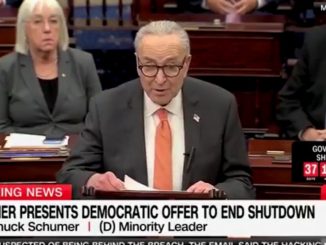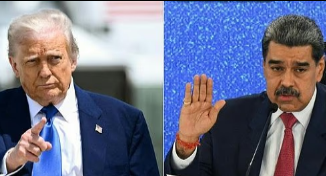
The Democratic base is in an unhinged uproar this morning after a handful of Senate Democrats cut a face-saving ‘deal’ to reopen the government.
Published November 10, 2025
August Moment: Senate Breakthrough
The federal government shutdown that dragged on for 40 days has finally moved toward resolution. On Sunday night, the United States Senate voted 60-40 in favor of a continuing resolution (CR) to reopen the government and fund key portions of federal operations — marking a critical turning point in what many called a historic shutdown.
The resolution funds military construction, the Department of Agriculture and the legislative branch through September 30, 2026, and keeps the rest of the government running through January 30.
Republican-Democrat Deal-Breakers
Perhaps most striking: eight Senate Democrats (including one Independent who caucuses with them) broke with party leadership to support the measure.
The Senators were:
-
John Fetterman (D-Pa)
-
Catherine Cortez Masto (D-Nev)
-
Jacky Rosen (D-Nev)
-
Dick Durbin (D-Ill)
-
Jeanne Shaheen (D-N.H)
-
Maggie Hassan (D-N.H)
-
Tim Kaine (D-Va)
-
Angus King (I-Me) — caucuses with Democrats
By stepping off the party line, these Senators opened a path toward reopening government — but the break also triggered internal backlash. As one outlet put it: the “Democratic base is in an unhinged uproar.”
Context & Stakes
-
The shutdown had persisted 40 days, straining government functions and programs.
-
Among the concessions gained in the CR: full-year funding for SNAP for the coming year, restoration of protections for federal employees against further firings, and a promise to schedule a vote on the Affordable Care Act (ACA) premium tax credits in December.
-
On the Republican side, leadership indicated that this vote unlocks further negotiations toward full-year appropriations bills.
Political Ramifications
For the Senators who broke from the pack, the risk is real: their leadership in the party may view the move as a betrayal, while voting to reopen the government gives them a tangible public service argument (especially in states with large federal or contractor workforces).
— For example, Senator Kaine emphasized protecting federal workers and their pay.
— Senator Durbin pointed out that the bill “is not perfect, but it takes important steps to reduce their shutdown’s hurt.”
— Meanwhile, critics within the party framed the move as caving to Republican demands and weakening the party’s leverage.

The shutdown left 42 million Americans with no access to their SNAP benefits, forced airlines to cancel thousands of flights and left more than a million federal workers without an income


Dick Durbin (left) and Jeanne Shaheen (right) are two of the Democrats who voted to end the shutdown. Both are retiring in 2026


Catherine Cortez Masto (left) and John Fetterman (right) are two other Democrats who opted to vote with Republicans. The duo will face re-election in 2028


‘Pathetic. America deserves better,’ Newsom wrote on X. His press office added: ‘Pathetic. This isn’t a deal. It’s a surrender. Don’t bend the knee!’

Senate Majority Leader John Thune (R-SD) revealed earlier on Sunday that progress was being made toward a deal

Senate Minority Leader Chuck Schumer (pictured) has been locked in tense negotiations to get a deal through. He revealed on Sunday he would oppose the Republican plan
 Implications of this bipartisan Senate move — politically, economically, and internationally:
Implications of this bipartisan Senate move — politically, economically, and internationally:
🏛️ 1. Political Implications: Cracks in Party Unity
-
The decision of eight Senate Democrats to side with Republicans exposes serious fractures within the Democratic Party.
-
It signals growing discontent among moderates who are prioritizing governance and constituent welfare over party loyalty.
-
Progressive activists and media figures are already calling out these senators as “traitors” or “sellouts,” suggesting a deeper ideological split ahead of the 2026 elections.
-
For GOP leaders, the vote is a strategic win—proving that bipartisan pressure can override party discipline when voters’ patience runs thin during economic disruption.
-
The “meltdown” reactions reported by The Gateway Pundit highlight how this event could reshape future negotiations within the Democratic caucus, possibly forcing leadership to adopt more centrist or compromise-driven positions.
💰 2. Economic Implications: Market and Worker Relief
-
The end of the 40-day shutdown restores federal paychecks, clears delayed contracts, and allows agencies to resume spending—an immediate boost to consumer confidence and liquidity.
-
The continuing resolution (CR) also stabilizes markets jittery over U.S. fiscal paralysis, especially defense, energy, and agriculture sectors tied to federal funding.
-
With the new short-term budget covering operations until January 30, 2026, Wall Street gains breathing space—but uncertainty could return if long-term negotiations falter.
-
For U.S. allies and trade partners, this signals a return to policy predictability—vital for maintaining import/export schedules, defense procurement, and multilateral project funding.
🌍 3. Geopolitical Implications: U.S. Credibility on the Line
-
Internationally, prolonged shutdowns weaken Washington’s image as a reliable partner and global leader.
-
The Senate’s bipartisan rescue vote suggests resilience in the U.S. system, reassuring allies who depend on steady American defense and diplomatic commitments.
-
For regions like the Indo-Pacific—especially the Philippines, Japan, and Australia—this stability is crucial in maintaining joint military operations and deterrence frameworks amid tensions with China.
-
Foreign policy analysts are watching to see if this moment restores faith in bipartisan governance, or if it merely delays another fiscal cliff early next year.
⚖️ 4. Electoral Implications: Voter Sentiment in Play
-
The eight senators who broke ranks will likely face primary challenges from progressives accusing them of undermining party leverage.
-
Yet, in moderate or swing states, voters may reward pragmatism over partisanship—especially federal workers and contractors who suffered during the shutdown.
-
The GOP can now brand itself as the “governing party”, positioning Republicans as solution-seekers versus ideological obstructionists.
-
If the shutdown’s end produces tangible economic improvement, voter frustration may pivot away from Congress as a whole and toward the more radical factions perceived as causing gridlock.
📈 5. Strategic Outlook: A Temporary Peace
-
This resolution is a truce, not a treaty—lasting only until January 30. The same divisions could reignite if negotiations over full-year appropriations stall.
-
The eight Democrats’ defection could inspire future bipartisan coalitions, especially on budget and border issues, but also intensify internal party discipline ahead of campaign season.
-
Globally, financial institutions and allied governments will treat this as a test case for U.S. stability, monitoring whether Washington can avoid repeating self-inflicted fiscal crises.


Pictured: Independent Angus King (left), who caucuses with the Democrats, and Democrat Maggie Hassan, both voted in favor of the Republican proposal


Jacky Rosen (left) and Tim Kaine (right) rounded out the group of seven Democrats and one Independent who sided with Republicans to get a deal done on Sunday night
 Overall Takeaway: A Vote That Redefined the Lines
Overall Takeaway: A Vote That Redefined the Lines
The Senate’s bipartisan decision to end America’s longest shutdown in modern history marks more than a procedural victory — it’s a moment of political recalibration. Eight Democrats crossing the aisle revealed a rare flash of courage in a chamber paralyzed by partisanship. Their votes didn’t just reopen government offices; they reopened the possibility of cooperation in a deeply divided Washington.
Yet the cost of that courage is still unfolding. Progressive outrage and leadership friction within the Democratic Party suggest that the price of pragmatism may be political isolation. The coming months will test whether these senators’ defiance inspires a new centrist coalition or fuels deeper ideological warfare ahead of 2026.
Beyond Capitol Hill, the resolution delivers short-term relief to markets, workers, and U.S. allies who depend on a functioning Washington. The world has been reminded that, despite its internal strife, America’s system still bends before it breaks — capable of self-correction through dissent.
For global observers and partners like the Philippines, this development matters: U.S. fiscal stability is more than domestic politics; it shapes defense cooperation, investment flows, and foreign policy commitments.
The government is open again — but the deeper question lingers: Has Washington learned to govern again, or merely to pause the next crisis?
SOURCES: THE GATEWAY PUNDIT – MASSIVE Leftist Meltdowns Ensue as Eight Senate Democrats Cave and Vote to End Government Shutdown – Here Are Some of the Biggest
FOX NEWS – Eight Senate Democrats break ranks with party leadership to end historic government shutdown
DAILYMAIL ONLINE – Newsom blasts ‘pathetic’ Democrats for ‘surrendering’ to Trump as ‘gang of eight’ senators join Republicans to end longest government shutdown in US history





1 Trackback / Pingback